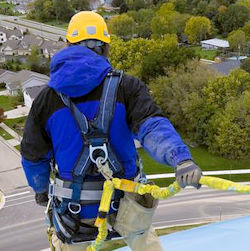Harness and Lanyard
Harness Hardware
Inspect all hardware closely for damage and or deformation. Check to see if tongue buckles have been bent or side loaded. Ensure that hardware functions properly and goes together smoothly without undo force.
The striking area should not be mushroomed to the point that splinters or shards will break off when they are struck.
Lanyard
Check that rope or webbing does not show signs of being "hooked back" on itself unless the lanyard is specifically designed by the manufacturer for "tie-back" use. (See DBI-SALA® and Miller) Ropes should be smooth, without knots and should be in unmodified manufacture condition. Any lanyard found to be discolored, knotted, cracked, frayed or have loose fibers, should be replaced. Attached shock-absorbing packs should be free of holes, tears, and stitching should be free of rips or loose strands.
Knowledge Check Choose the best answer for the question.
4-3. Which of the following conditions indicates a lanyard is probably safe for use?
You forgot to answer the question!

